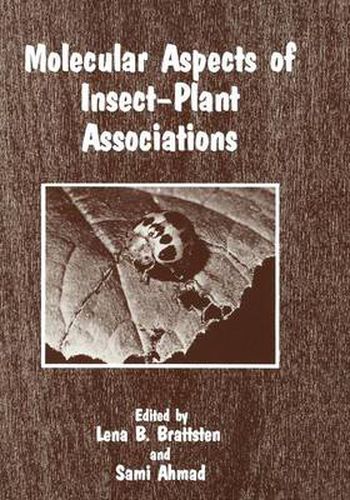Molecular Aspects of Insect-Plant Associations
S. Ahmed,L.B. Brattsten

Molecular Aspects of Insect-Plant Associations
S. Ahmed,L.B. Brattsten
This title is printed to order. This book may have been self-published. If so, we cannot guarantee the quality of the content. In the main most books will have gone through the editing process however some may not. We therefore suggest that you be aware of this before ordering this book. If in doubt check either the author or publisher’s details as we are unable to accept any returns unless they are faulty. Please contact us if you have any questions.
Thanks to the meticulous and enthusiastic work of insect collectors and taxonomists over the past hundred years and more, we have today a large amount of information on the feeding habits and life styles of sev eral hundred thousands of insect species. Insects that feed on plants during at least one of their life stages constitute about half of the three-quarters of a million described species. Their numbers both in terms of species and individuals together with their small but macroscopic sizes makes the insect-plant biological interface perhaps the most conspicuous, diverse and largest assemblage of intimate interspecies interactions in existence. It is also perhaps the most important biological interface be cause of the plants’ role as primary producers upon which all other forms of earthly life depend, thereby bringing herbivorous insects occasionally into direct competition with human food and fiber production. Early enthusiasm revealed many remarkable specializations and associ ations between insects and plants, and occasionally assigned chemical me diators for them. However, the modern practices of large scale crop pro tection by synthetic pesticides and their attendant problems, particularly with resistance in pests and destruction of natural enemies, have been in large measure responsible for drawing our attention to the mechanisms whereby plants control insect populations and insects adapt to the plants’ defenses. These practices have also brought home the importance of chemical mediators in practically all aspects of insect activities and, in parti cular, the importance of plant allelochemicals in maintaining and balan cing insect-plant associations.
This item is not currently in-stock. It can be ordered online and is expected to ship in 7-14 days
Our stock data is updated periodically, and availability may change throughout the day for in-demand items. Please call the relevant shop for the most current stock information. Prices are subject to change without notice.
Sign in or become a Readings Member to add this title to a wishlist.


